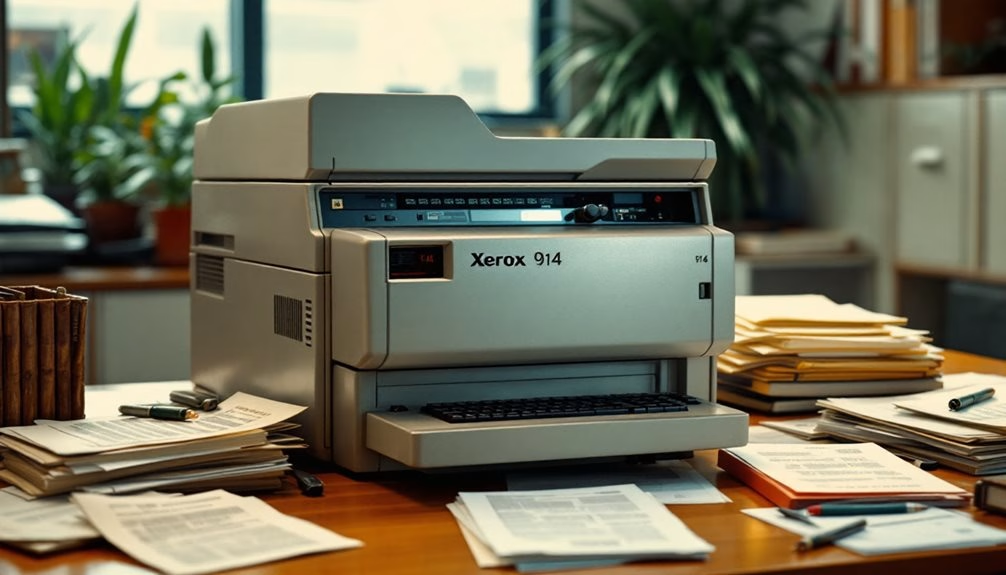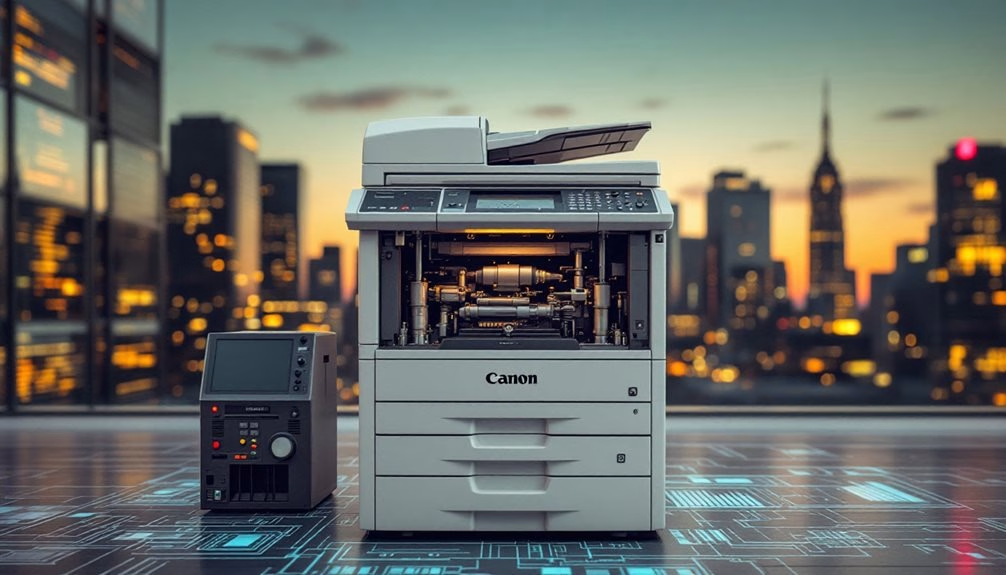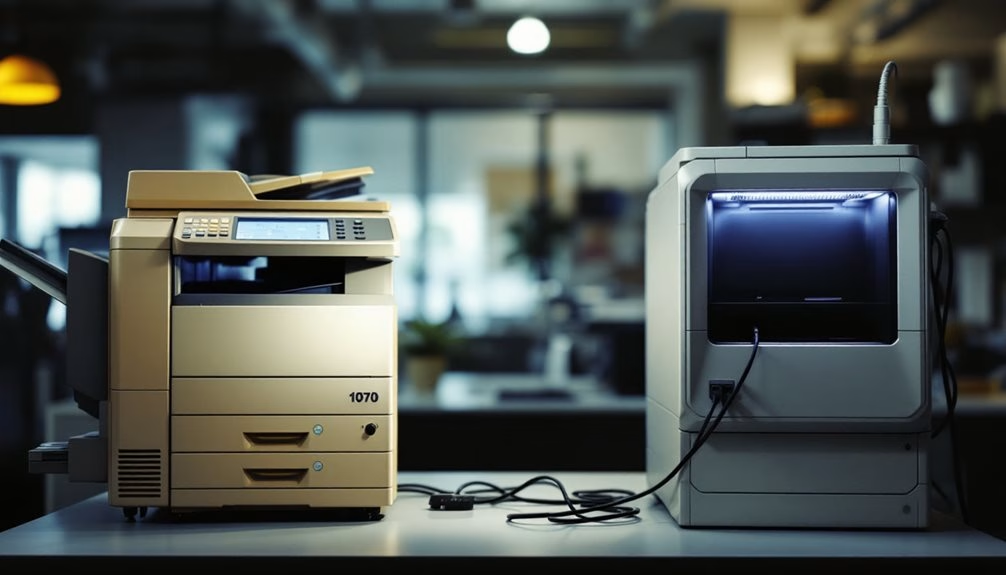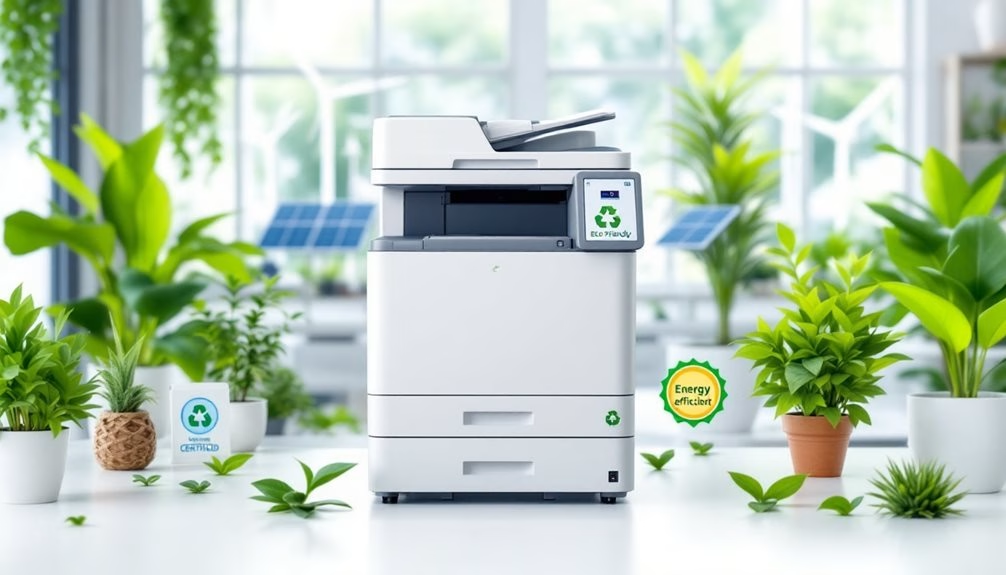The history of top copier brands shows how office technology has revolutionized business communication. Xerox pioneered plain-paper copying in 1959, changing document reproduction forever. Canon challenged their dominance in the 1980s with innovative personal copiers. Later, Ricoh and Konica Minolta led the digital transformation toward paperless solutions. Today’s multifunction devices from HP and others integrate multiple capabilities while emphasizing sustainability. The journey from simple copiers to networked hubs reveals how these technologies shaped modern workflow.
Expert Highlights
- Xerox transformed office communication in 1959 with the 914 copier, making document reproduction accessible to all businesses.
- Canon challenged Xerox’s dominance in the 1980s with innovative personal copiers featuring replaceable cartridge systems.
- Ricoh and Konica Minolta pioneered digital transformation in the 1990s, shifting focus to paperless solutions.
- Multifunction devices from HP and Canon combined printing, scanning, copying, and faxing into collaborative workflow centers.
- Environmental sustainability has reshaped copier design, with major brands adopting energy-efficient technologies consuming up to 70% less power.
Xerox: How the First Plain-Paper Copier Revolutionized Office Communication

When Xerox introduced the 914 in 1959, the world’s first successful plain-paper photocopier changed office communication forever.
This breakthrough innovation made document reproduction accessible to businesses of all sizes, not just those with specialized equipment.
We’ve come to take copying for granted, but imagine a world where sharing information required carbon paper or messy mimeograph.
The 914 lets quickly duplicate documents at the touch of a button.
Xerox’s innovation created a company so synonymous with copying that “xeroxing” became a verb.
Xerox didn’t just dominate the market—it literally became the language of document reproduction.
It’s worth remembering that every time we share materials in meetings, we’re benefiting from this revolutionary technology.
Today’s businesses can access this legacy through flexible leasing options that make advanced copying technology accessible without significant upfront investment.
Canon’s Rise: Engineering Innovation and Market Competition in the 1980s

While Xerox dominated the copier industry throughout the 1960s and 70s, the landscape shifted dramatically in the 1980s with Canon’s emergence as a serious competitor.
Canon’s breakthrough came with their PC-10 personal copier in 1982, bringing affordable copying technology to small businesses like ours.
Their revolutionary replaceable cartridge system simplified maintenance and reduced downtime we’d previously accepted as unavoidable.
We saw Canon’s market share surge as they perfected innovations Xerox had overlooked.
Today, Canon remains among the premium brands offered alongside HP, Xerox, and Ricoh for businesses seeking reliable office technology solutions.
The Digital Transformation: How Ricoh and Konica Minolta Led the Paperless Movement

As the 1990s unfolded, Ricoh and Konica Minolta emerged as pioneers in the digital revolution that would fundamentally change our relationship with document management.
We witnessed these brands transform from traditional copier manufacturers into architects of the paperless office. Their innovations—networked document systems, cloud storage solutions, and workflow automation—redefined what we expected from office equipment.
Rather than simply reproducing documents, we now had partners helping us transition to digital workspaces. Their integrated platforms allowed us to scan, store, and share information seamlessly across our organizations.
Together, we’ve embraced this digital shift, reducing our environmental footprint while increasing productivity.
These modern multi-function printers have demonstrated lower total cost of ownership by 30% compared to traditional systems while offering high-yield toner options.
From Standalone Machines to Networked Hubs: The Evolution of Multifunction Devices

The transformation from isolated copiers to integrated multifunction devices represents one of the most significant shifts in office technology history.
We’ve witnessed standalone copiers evolve into networked hubs that connect our entire workflow ecosystem.
Companies like HP and Canon pioneered this integration, combining printing, scanning, copying, and faxing capabilities into single units that serve as collaborative centers.
Industry leaders transformed document devices from isolated tools into integrated hubs that now anchor our collaborative workflows.
Today’s MFPs don’t just reproduce documents—they facilitate our digital communication, cloud connectivity, and security protocols.
They’ve become central to how we share information and build workplace communities, turning previously isolated tasks into interconnected experiences that bring our teams closer together.
Modern MPS solutions implement proactive maintenance to prevent issues before they occur, extending equipment life and minimizing workplace disruptions.
Environmental Sustainability and the Modern Copier Industry’s Green Revolution

Environmental concerns have fundamentally reshaped how copier manufacturers design, produce, and market their products in recent years.
We’re witnessing a green revolution where brands like Xerox, Canon, and Ricoh have implemented energy-efficient technologies and recyclable components.
Today’s eco-friendly copiers consume up to 70% less power than predecessors through Energy Star compliance and smart sleep modes.
We’ve also seen manufacturers embrace closed-loop recycling programs, where toner cartridges are reused rather than discarded.
As businesses seeking sustainable solutions, we can now choose machines that align with our environmental values while maintaining productivity—a win for both our planet and bottom line.
At JR Copier, we offer premium equipment solutions that keep pace with these environmental industry advancements while focusing on exceptional reliability.
Frequently Asked Questions
How Did Copier Leasing Models Transform Small Business Operations?
We’ve seen copier leasing revolutionize our small businesses by eliminating upfront costs, providing maintenance support, and allowing us to upgrade equipment regularly—keeping us competitive without breaking the bank.
What Legal Battles Shaped Intellectual Property Rights in the Copier Industry?
We’ve seen how Xerox v. SCM and Ricoh v. Katun lawsuits revolutionized our industry by establishing fair use doctrines and aftermarket rights that now protect our ability to service copiers affordably.
How Did Japanese Manufacturers Initially Break Into Western Copier Markets?
We’ve seen Japanese manufacturers enter Western copier markets through ruthless price undercutting, innovative technology, quality-focused manufacturing, and establishing strong distribution networks—while wisely adapting their marketing to Western business sensibilities.
Which Copier Brand Had the Highest Market Share Throughout History?
Xerox has maintained the highest market share throughout copier history. We’ve watched them dominate the industry since the 1960s, though Canon and Ricoh have challenged their throne in recent decades.
How Did Cold War Tensions Affect Copier Technology Development?
Cold War tensions drove our copier tech forward as we raced to protect documents from espionage. We’ve seen how security features and miniaturization evolved from East-West competition for information superiority.
Expert Final Thoughts
We’ve seen how these pioneering brands transformed business communication over decades. From Xerox’s groundbreaking plain-paper technology to today’s networked multifunction hubs, copiers have evolved beyond simple reproduction tools. As we embrace digital workflows, Canon, Ricoh, and Konica Minolta continue pushing boundaries with sustainability at the forefront. What began as office machines have become essential business platforms that connect, streamline, and support our increasingly paperless world.
About the Expert
Rafael M.
CEO of JR Copier
With over 35 years of hands-on experience in the copier and office printer industry, Rafael brings unparalleled expertise to every client interaction. His journey from service technician to CEO provides him with comprehensive understanding of all aspects of the business.
Areas of Expertise: Copier and printer sales, equipment leasing strategies, maintenance solutions, and managed print services. Rafael's deep industry knowledge ensures clients receive expert guidance, transparent pricing, and exceptional service for all their office equipment needs.
Connect on LinkedIn